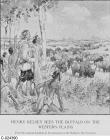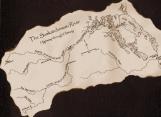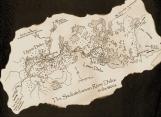1
The Saskatchewan River - 'Highway Through History'(Click on maps or photos throughout this exhibit for a larger view.)
3
The Saskatchewan River has had tremendous impact on the lives of people living within its watershed over the centuries. It was instrumental in the development and settlement of the land that was to become western Canada.4
Henry Kelsey, first European to see the North American prairies, watching buffalo on western plains.1691
unknown location

5
As western Canada's first 'highway', the Saskatchewan River was travelled by a litany of renowned explorers, traders, adventurers and artists including Henry Kelsey, Pierre and Louis-Joseph La Verendrye, Samuel Hearne, Anthony Henday, Peter Fidler, Peter Pond, Alexander MacKenzie, Sir John Franklin and Paul Kane, to name but a few.7
This exhibit focuses on the lower Saskatchewan River - the final 440-kilometre stretch of river that spans the Manitoba/Saskatchewan border and empties into Lake Winnipeg at Grand Rapids. Over this section, the waterway forms one of the largest inland river deltas in North America. This unique formation with meandering river and creek channels, shallow lakes and extensive marshes is one of western Canada's premier wildlife areas.8
A remnant glacial moraine ridge divides the delta into two distinct sections - the upper and lower deltas. After fanning out into the vast lakes, streams and marshes of the upper delta's Cumberland area, the river's myriad braids are hemmed in and forced to converge into a single channel that cuts through the moraine at The Pas. (The name 'The Pas' is derived from the Cree term 'Wapasquia' or 'Opasquia' that means 'the high wooded narrows'.) Once free of the moraine, the river fans out again into the vast wetlands of the lower delta before emptying into Lake Winnipeg.10
During the fur trade, the lower Saskatchewan River saw the most concentrated flow of furs of any river in the country. It was a literal crossroads for the trade. Almost all of the furs traded from the prairies and foothills, and from the vast reaches of the Athabasca territory funnelled down this historic stretch of water. Once reaching Lake Winnipeg however, the routes diverged, with the Hudson's Bay Company brigades travelling down the Hayes River to York Factory, while the North West Company and other Montreal traders went south to Rainy River, the Grand Portage to Lake Superior, and on to Montreal.11
A number of 'firsts' are associated with the lower Saskatchewan River, including:- The first non-Aboriginal ever to see the prairies was Henry Kelsey. His expedition took him up the Saskatchewan River, and he over-wintered on its shores near the present site of The Pas in 1690-91;
- The first grain ever cultivated in western Canada was grown along the shore just upstream from The Pas in 1753 by Louis de la Corne;
- The first inland trading post established by the Hudson's Bay Company, Cumberland House, was built on the river at Pine Island by Samuel Hearne in 1774;
- The first Aboriginal Anglican Priest in North America, Henry Budd, was ordained in 1853 and served at communities throughout the Saskatchewan River delta.


